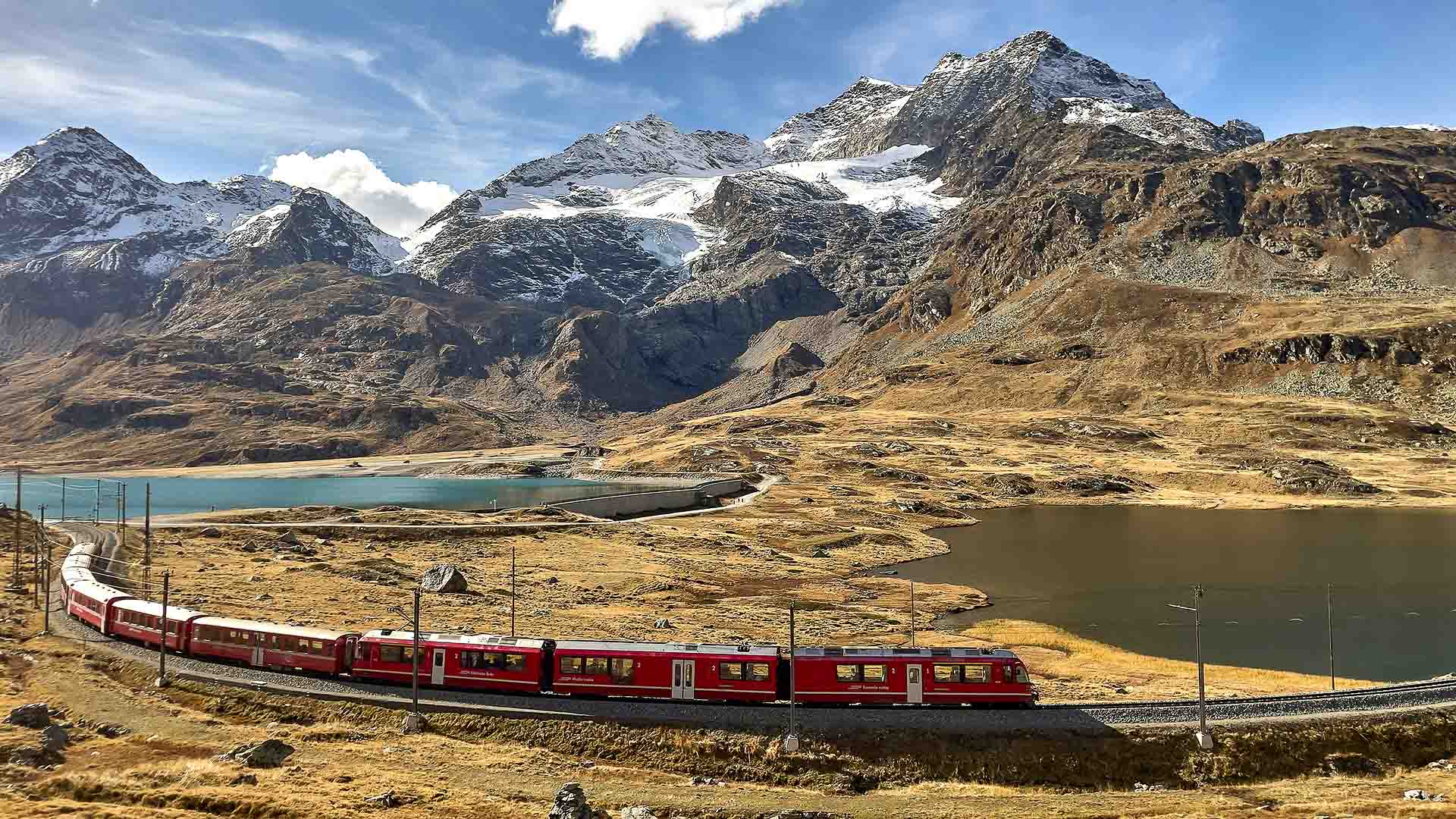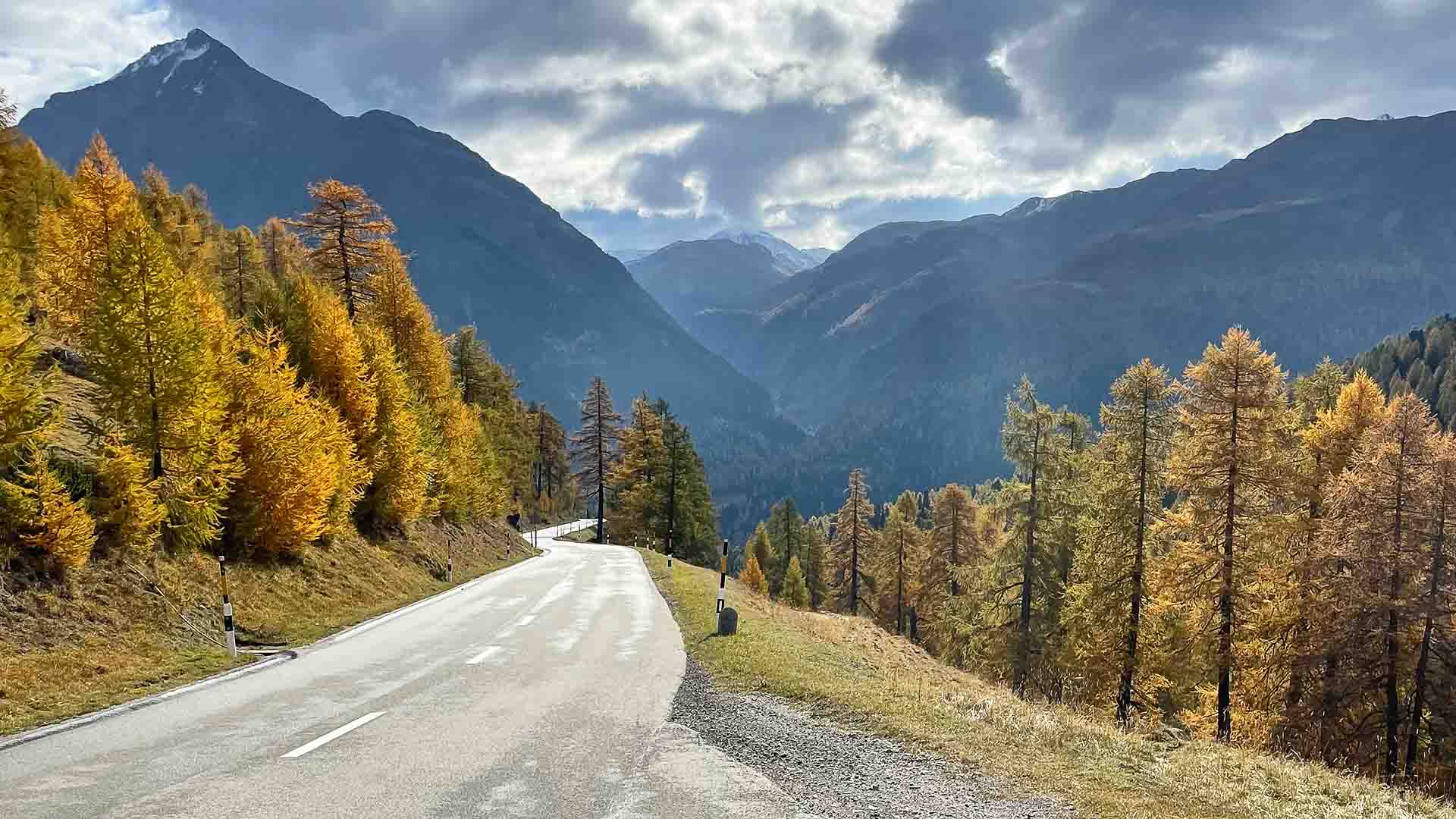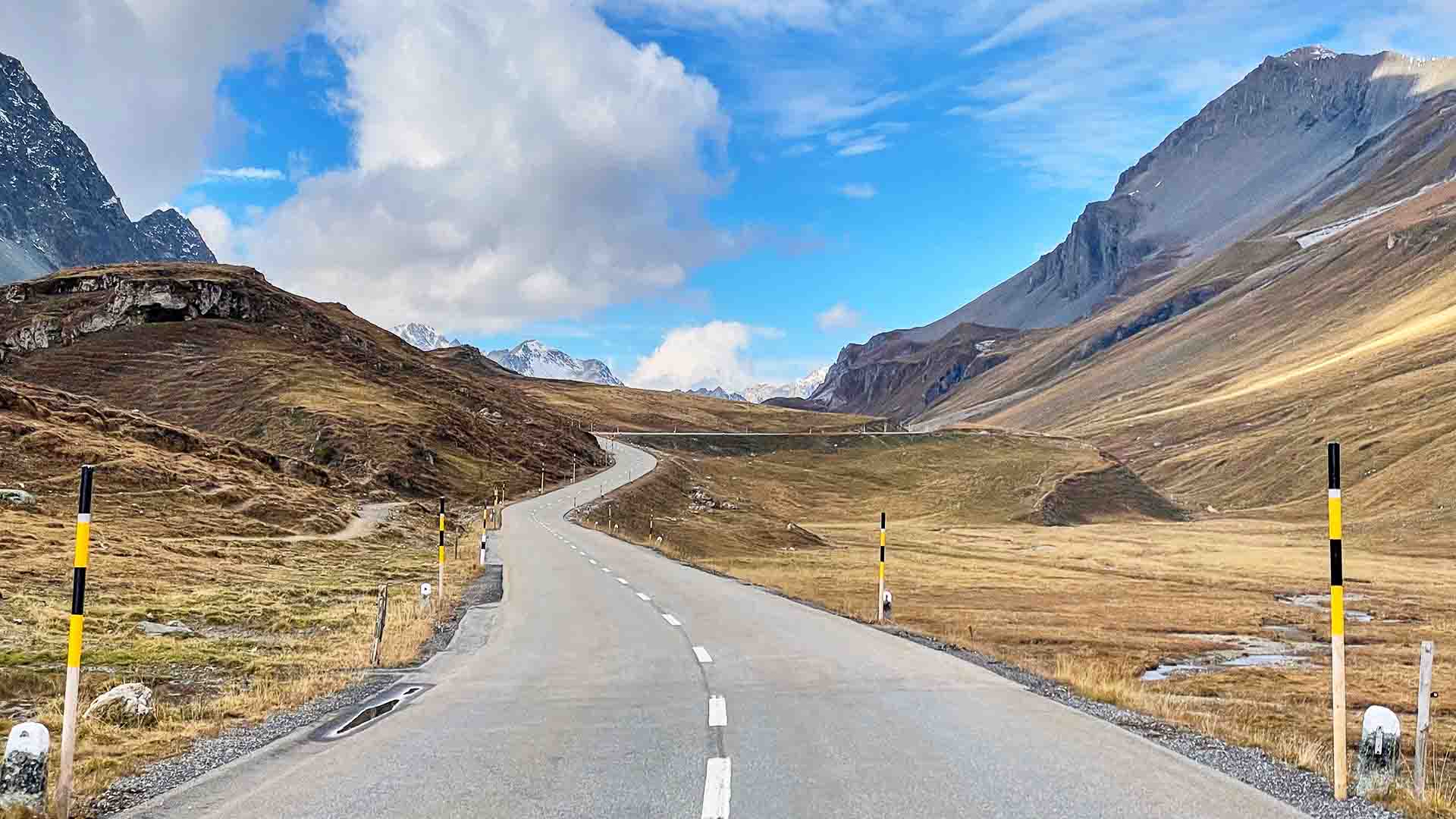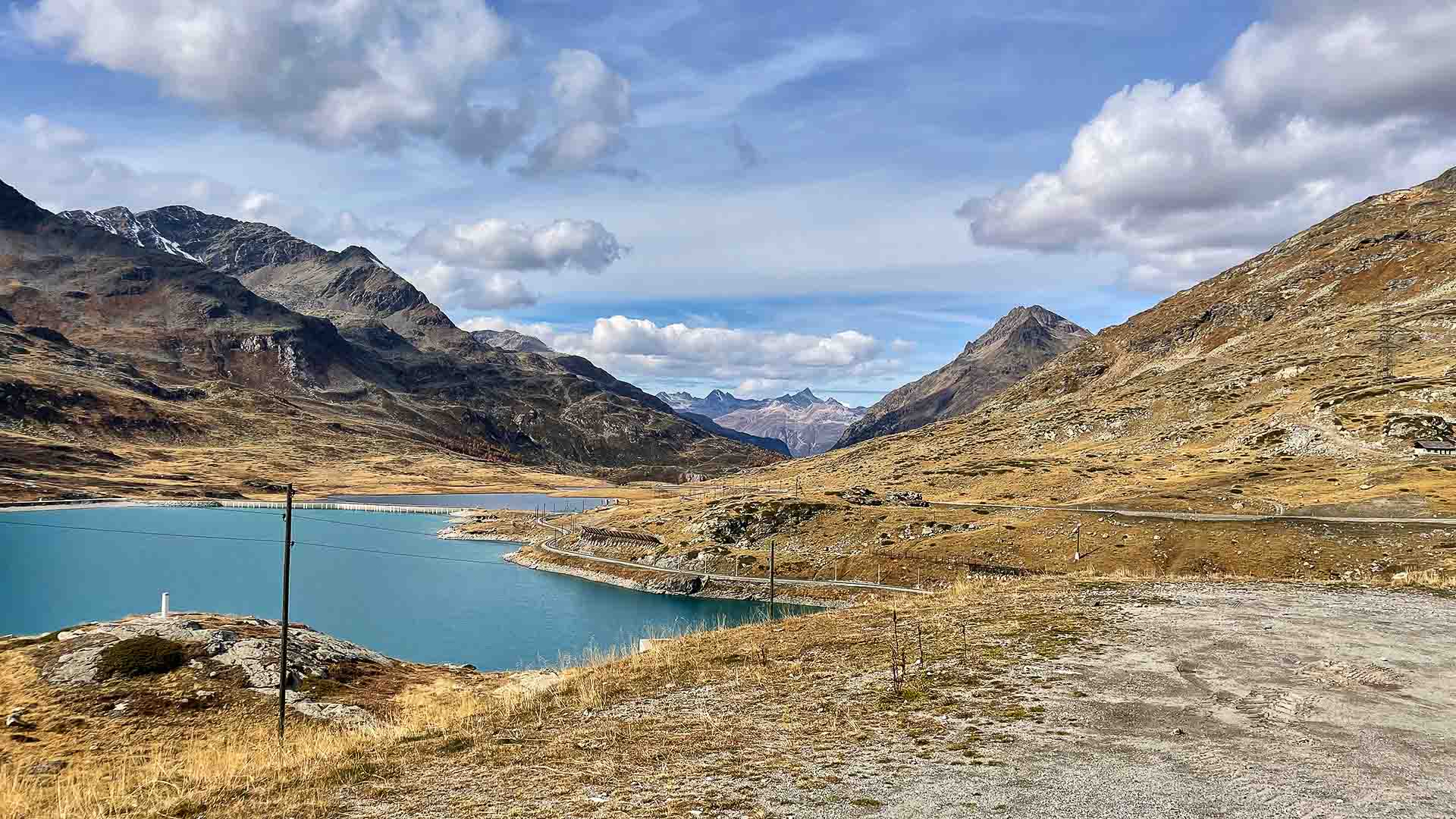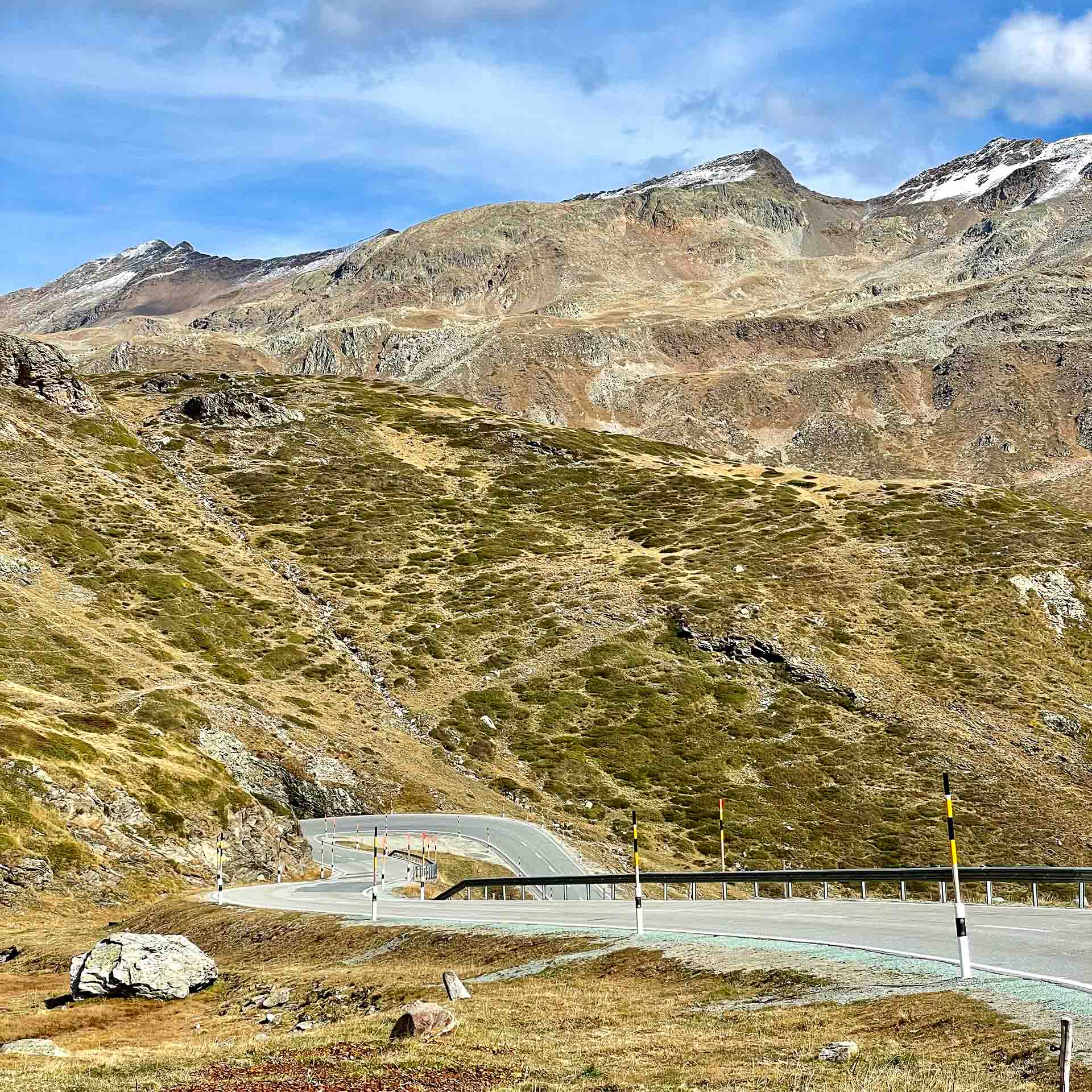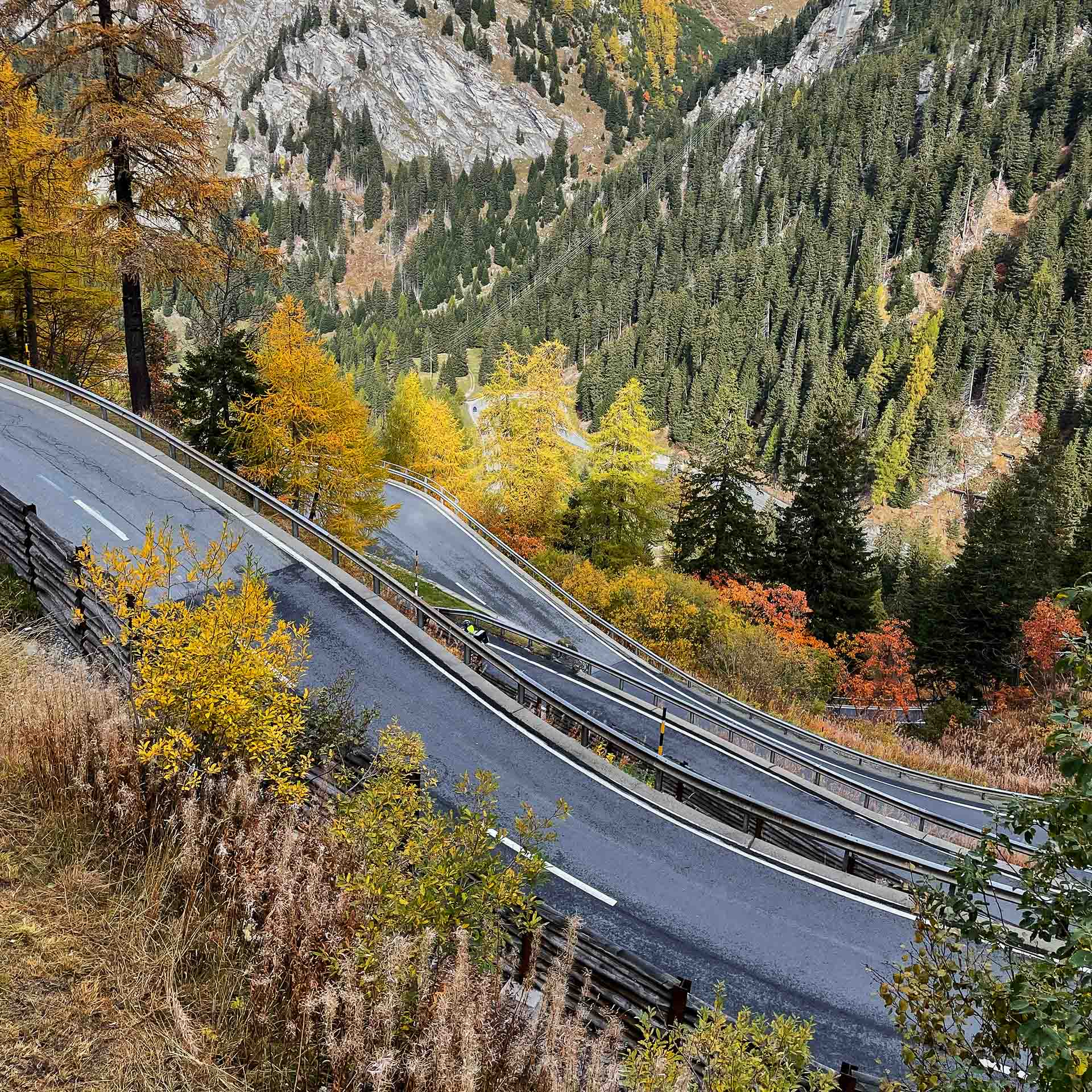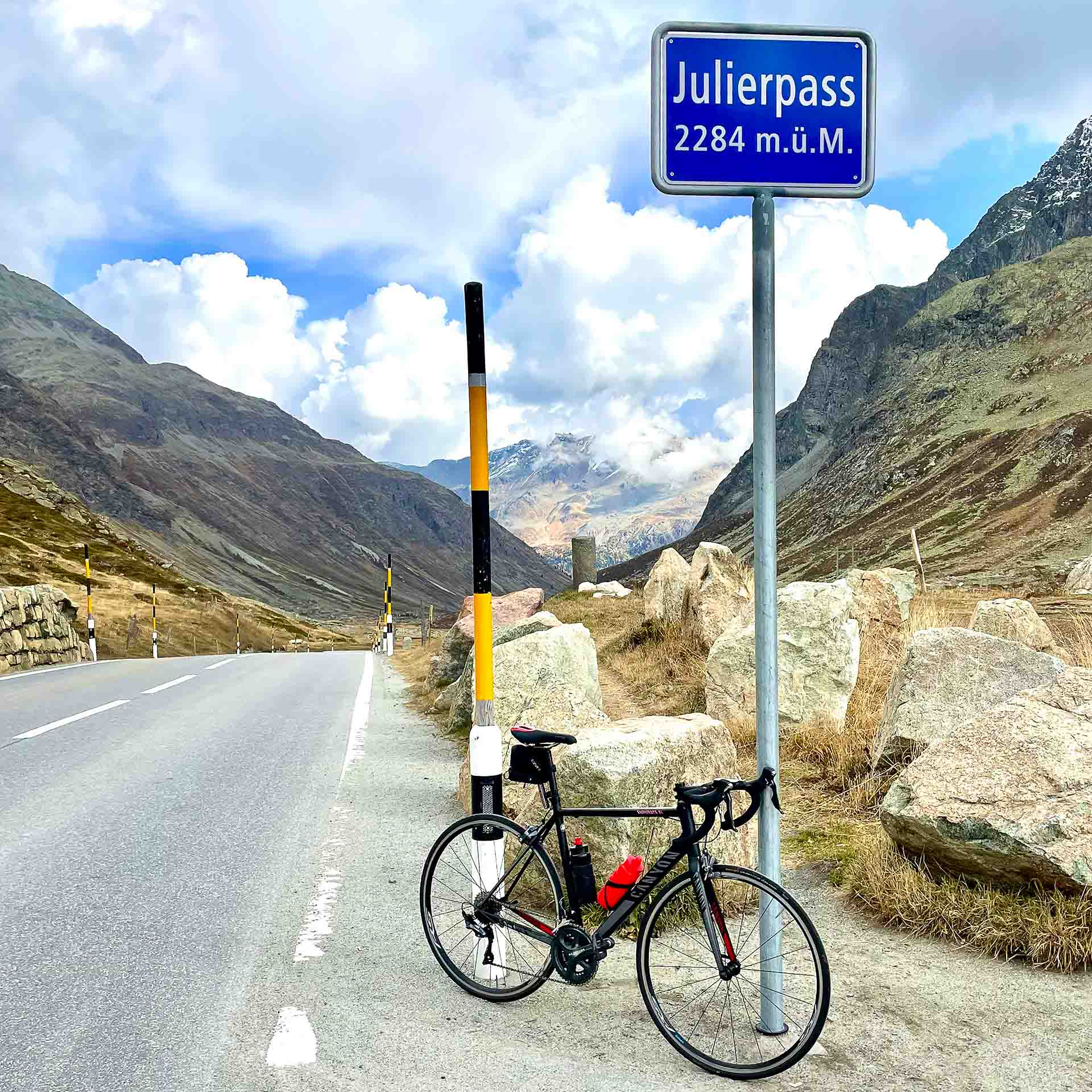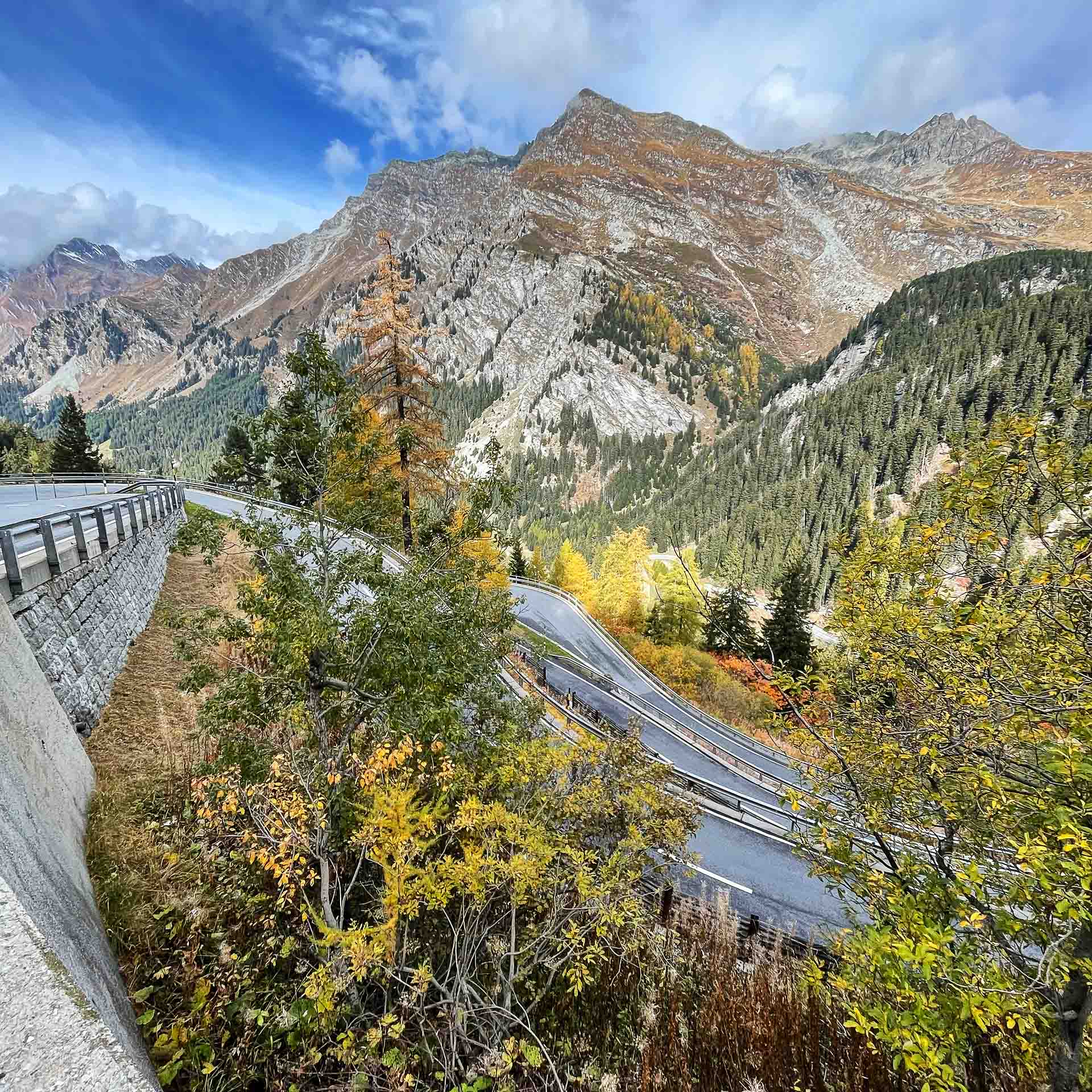If cycling up mountain passes is your thing, it’s time to check out the cycling around Switzerland’s St Moritz and the Engadin Valley.
From here you can launch assaults on some of Switzerland’s biggest cycling climbs, including the Albula Pass, Bernina Pass, Julier Pass, and Maloja Pass.
No wonder then that the Tour de Suisse is a regular visitor.
In this guide, reader Patrick Quayle shares his experiences of riding the Engadin Valley. Below you’ll find links to cycling routes up the Albula, Bernina, Julier and Maloja passes. You’ll also find tips for hopping the border to Italy as well as bike hire, where to stay, when to visit and how to get here.
Why should cyclists visit St Moritz and the Engadin Valley?
The Engadin Valley is a high valley situated in the Eastern Alps in the far south eastern corner of Switzerland. It sits near the border with Italy in the canton of Graubünden, just under 100 kilometres from Bormio (which is of course home to the Stelvio).
The region is known for its sunny weather (it claims 300 days of sunshine a year) and spectacular scenery. Here you’ll find green meadows, forests, crystal lakes, and majestic mountains aplenty. The Engadin is home to the famous ski resort of St Moritz and although it’s better known for its winter sports, it’s also a mecca for summer sports. Many athletes base themselves here for high altitude training.
Despite St Moritz’s glitzy reputation, it’s not all about high glamour and the super rich. There are many less assuming (and nicer) villages along the valley including Maloja, Sils, Silvaplana and Pontresina, among others.
There are literally hundreds of kilometres of mountain bike trails and with the opportunity to take bikes up in the gondolas, mountain biking St Moritz and the Engadin Valley is a great option if you feel like taking a break from the road.

Map of Switzerland’s cantons, with Graubünden in the bottom right corner
Cycling routes in the Engadin Valley
The main passes in the Engadin Valley are the Albula Pass, Bernina Pass, Julier Pass, and the Maloja Pass.
There are even more on offer if you want to venture a bit further afield. For example the Maloja route below could be extended to take in the Splügen Pass with a return via Tiefencastel and the Julier Pass. But that is quite a challenging ride.
You could also head over the border into Italy and combine a cycling holiday in Switzerland with a trip to Bormio to conquer the Stelvio, Gavia and Mortirolo.
Must-do cycling climbs/routes
Here are the rides I did and loved.
For more cycling routes elsewhere in Switzerland, read this.
What are the key road cycling events in the Engadin
The Tour de Suisse often visits the region. In 2023, La Punt, where we started the Albula Pass climb, will host the end of stage 5 and the start of stage 6 on 15-16 June 2023. This is one of the main precursors to the Tour de France and a lot of the big name riders and teams use it as a final training race to prepare.
The Giro d’Italia often reaches into these parts too.
The Engadin Cycle Marathon is a three day event that takes place in Zernez further down the Engadin Valley at the end of June and beginning of July. There are three events that people can sign up for.
On one day each September, the authorities close the whole Albula Pass to cars and let only cyclists use the road. The event is called SlowUp Albula Mountain.
What are the best hotels for cyclists in St Moritz and the Engadin Valley?
I was lucky enough to be staying with family in Silvaplana, so did not need to find accommodation.
Being such a well known ski destination there are loads of hotels and guesthouses across all the villages and towns in the Engadin. Most hotels are used to dealing with ski equipment and as such will have designated ski rooms usually in the basements. In the summer these can usually be used as bike storage. I am sure if you have a priceless Pinarello you can ask to keep it in your room!
Are there places for bike hire in St Moritz and the Engadin Valley?
Prices, services and bike brands often change. Please let us know if anything is incorrect.
There are lots of bike shops in the Engadin Valley. Many are focused on mountain bikers, but there are still a good range of road bike shops. Options include Bcyclet, CCT Bike Rental and Suvretta Sports.
When to visit the Engadin Valley
The best time to visit the Engadin is the summer when you can be most sure of good weather.
Spring and autumn can also be a good time. The Engadin is renowned as having one of the highest number of sunny days in Switzerland so there is a good chance you will get nice dry riding. That said it is a region in the High Alps and mountain weather can be notoriously unpredictable.
Although some of the main road passes are open during winter, they do get busy with ski traffic and even the busiest ones usually get closed at some point due to heavy snow. Whilst it is possible to ride through most of the winter, it is probably just not advisable until late spring in April/May. From then until early October the roads are usually all open and great for cycling.
In the height of summer it can get very warm, but there are an abundance of nice lakes to cool off in. It is very picturesque in all seasons, in spring and summer the valleys are full of green meadows and spring flowers and in autumn the larch trees go an amazing gold colour.
Bear in mind the events mentioned above – you may either want to time your visit to see/take part in them or avoid them!
And a final tip: the Engadin is easy to spot on the Swiss weather report maps as it is the region in very the bottom right hand corner with the three lakes in a row!
Tips for cycling in the Engadin Valley
Altitude
Bear in mind the altitude when cycling here. I was in fairly good shape when I was in the Engadin, however the harder rides were pretty tiring.
I am used to pretty big days of climbing especially in Tenerife and Gran Canaria. While I may easily cover more vertical ascent there, you are climbing from sea level and so it’s much easier. Here you are staying at altitude, descending and climbing back up; this takes its toll.
Training
If you want to tackle some of the longer routes, I would recommend doing a good block of training before visiting. Of course, this is all relative to how hard you ride and how much you wish to do while in Switzerland.
Kit
It is advisable to pack a wide range of clothing. Being up in the mountains, the weather can be fickle and change very rapidly.
The climbs are long and you will get warm, conversely the descents are fast and you will get cold quickly. The wind always seems to have a chill, so a windproof shell is a good idea. Sunscreen is also a good idea the air is thinner and it is easier to catch more sun than you may think.
I visited in mid October. It was very cold early in the mornings and warmed up relatively quickly if the sun was out.
My kit for the autumn was:
- Summer bibs
- Leg warmers
- Thermal and regular socks
- Gloves, fingerless and light winter
- Merino base layers in long and short sleeve
- Light winter jacket
- Rain jacket
I ended up using most of it, often setting off with long gloves and changing to fingerless when it warmed up. I kept leg warmers on all the time and rode in the jacket with a long sleeve base or the long sleeve jersey with a long base. I never used short sleeve jersey, arm warmer combo. On some of the big climbs I just opened up the jacket zip and vents.
Gear for the bike
Some of these routes take you far away from towns and villages, so it’s best to be self- sufficient and carry spare tubes, CO2, pump and a multi tool. It is also advisable to carry enough nutrition to keep you well fuelled at all times.
All of the routes pass numerous towns and villages, most of which have plenty of options to stop and buy food and fill up bottles. However at times they can be far apart. I usually travel with a good stock of nutrition both powders for my water bottles, gels and bars. Better to have too much and bring stuff back home. Bananas are always easy to find wherever you are, and it is always good to sample the local pastries too!!
Visiting in autumn
I visited in mid October and by this time, most of the shops were transitioning into ski mode, so the majority of bike stuff is being put into storage. That said, I was still able to locate a shop with a track pump to inflate my tyres. My experience at that time of year is that it’s better to be prepared to be self-sufficient, especially as they seem to cater more for mountain bikers than they do roadies.
Local food
No trip to the Engadin would be complete without trying a slice of Engadiner Nusstorte a traditional cake/pastry filled with a paste of honey cream and walnuts. It may not sound that good, but it really is and it’s certainly a good way to replace some burned off carbs!
Of course Switzerland is famous as one of the best chocolate producing nations, but my go to choice is actually a kid’s chocolate called Ragusa that’s available in dark and milk chocolate.
Buses
The PostAuto or postal buses run along a lot of the routes. This is basically a public bus network of yellow busses over the whole of Switzerland and used to be a combination of a postal service with a bus network (I am not sure if they still carry post). Most of the Engadin Vally is covered by them.
It should be possible to take your bike on special racks on the back on popular tourist routes, but it’s worth checking the route and that your bikes will definitely be allowed beforehand (website is here).
Costs (and other useful info)
Switzerland is not a cheap country; be prepared to spend a bit more than you would be used to in the rest of Europe. However the good roads, fantastic infrastructure and high standards certainly help you feel it is money well spent.
Like the rest of Europe, the Swiss drive on the right hand side of the road.
Most Swiss people speak good English and most restaurants will have an English menu. Being right on the border with Italy there is also a lot of Italian influence too.
You can find out more about the Engadin area from the tourist board website here and here.
Highway code and travel information
As ever, it’s a good idea to check current travel information before you book and travel. For UK visitors, the UK government travel information pages for Switzerland are here.
You should also read and follow Switzerland’s highway code (and there’s a summary of some info for cyclists here).
Finally, it’s worth mentioning that trains go to many of the destinations I rode to on my trip, and the mountain railway is not only famous, but spectacular in equal measure. A great thing to do on a day off the bike!
How to get to St Moritz and the Engadin Valley
Engadin is just under three hours drive from Zurich.
Switzerland has one of the best public transport systems in Europe. There is a station at Zurich Airport; you would need to go to Zurich HB (the city’s main railway station, a short hop from the airport) and there are trains to St Moritz via Chur.
On the trains you will need two tickets to travel with a bike, one for you and one for the bike. Most Swiss people speak good English, and all of the ticket kiosks will help if you struggle with the machines. Some of the peak time trains do not allow bikes, so good to do as much research beforehand (train website with info on bikes is here).
The other option is to hire a car and drive from Zurich. The journey is around three hours depending how often you stop and having a car may be useful for the days you do not want to cycle or need to go shopping etc if you are self catering.
If you’re considering a trip into Italy, it’s worth knowing that Milan is also just under three hours drive from St Moritz.
Final thoughts
A huge thank you to Patrick for sharing these really useful insights with us. I think we can all agree that Switzerland’s Engadin Valley sounds absolutely stunning!
If you’re looking for more information on cycling in Switzerland, head to our Switzerland hub page. Amongst other things, you’ll find further Switzerland cycling routes as well as information on Switzerland’s famous gran fondo, the Tour des Stations.
Please support Epic Road Rides
A huge amount of time and effort goes into the article you’ve just read, all with the aim of helping you!
If you found what you’ve read useful, I’d really appreciate it if you dropped something in the tip jar here.
It’s a way you can say thank you and help us carry on creating top quality content with no annoying ads and no pay wall.
Looking for an organised cycling trip?
If you want someone to help you plan and book your cycling holiday, fill out this form. We aren’t a tour operator/agent but we work with lots of people who are and will do our best to put you in touch with someone that can help (within 24 hours wherever possible)!
The contents of this website are provided for general information purposes only. It is not intended to amount to advice and you should not rely on it. You should carry out your own due diligence and take professional advice. We make no representations, warranties or guarantees, whether express or implied, that the content on our website is accurate, complete or up to date. If you use any information or content on this website, download from, or otherwise obtain content or services through our website, it is entirely at your own discretion and risk. Epic Road Rides Ltd disclaims all liability and responsibility arising from any reliance placed on the information and content on this website. Find out more here.

